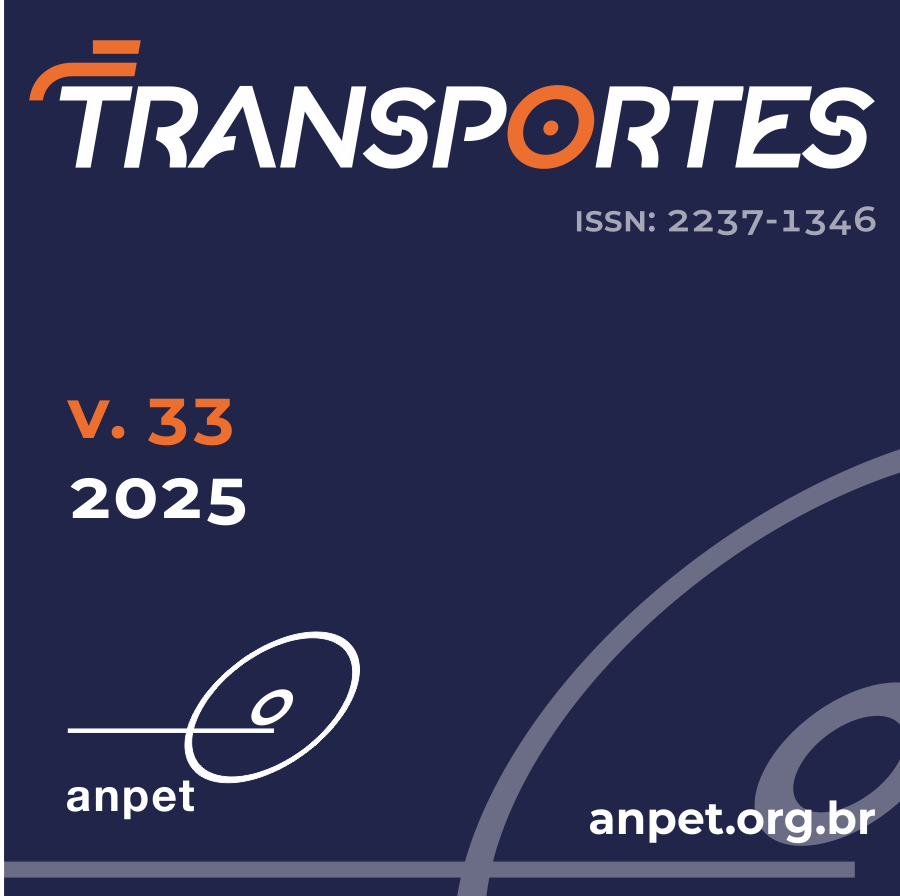Effects of fare variation on bus transit demand in Fortaleza considering spatial, temporal, and socioeconomic attributes
DOI:
https://doi.org/10.58922/transportes.v33.e3033Keywords:
Public transportation demand. Tariff elasticity of demand. Income elasticity of passengers. Bus demand decline.Abstract
Public bus transportation in Brazil has been facing a crisis, possibly stemming from the vicious cycle of declining demand. To understand this phenomenon, the scientific community suggests analyzing the relationship between fare and bus demand. However, few studies analyze how spatial, temporal, and socioeconomic characteristics may influence this causal relationship and, in general, do not rely on a priori models that theoretically support causality hypotheses, which can lead to biases in the analysis. Thus, this study seeks to examine the relationship between fare and demand based on a conceptual representation of the determinants that may influence it, grounded in a literature review. Therefore, a mental map is proposed to represent the causality hypotheses regarding the immediate-, medium-, and long-term effects of fare changes. Based on the available data, a causal diagram is developed to assess the direct and indirect effects of these variations over time, estimated through panel data regressions while controlling for spatial, temporal, and socioeconomic factors using fixed effects.
Downloads
References
Carvalho, C.H.R. e R.H.M. Pereira (2012) Efeitos da variação da tarifa e da renda da população sobre a demanda de transporte público coletivo urbano no Brasil. Transportes, v. 20, n. 1, p. 31-40. DOI: 10.4237/transportes.v20i1.464. DOI: https://doi.org/10.4237/transportes.v20i1.464
Carvalho, C.H.R. (2016) Aspectos Regulatórios e Conceituais das Políticas Tarifárias dos Sistemas de Transporte Público Urbano no Brasil. Brasília: Ipea. Disponível em: <http://repositorio.ipea.gov.br/handle/11058/6635 > (acesso em 30/06/2025).
Carvalho, C.H.R. (2021) Alteração da Base de Precificação e Custeio dos Sistemas de Transporte Público Urbano no Brasil. Tese (doutorado). Economia, Universidade de Brasília. Brasília, DF. Disponível em: <http://educapes.capes.gov.br/handle/capes/872626> (acesso em 30/06/2025).
Cascetta, E. (2009) Transportation Systems Analysis, Models and Applications (Vol. 29, 2a ed.). Berlin: Springer. DOI: https://doi.org/10.1007/978-0-387-75857-2_2
Castro, I.R. (2019) Compreensão das Mudanças no Uso do Solo e na Acessibilidade ao Trabalho da População de Baixa Renda em Fortaleza. Dissertação (mestrado). Engenharia de Transportes, Universidade Federal do Ceará. Fortaleza, CE. Disponível em: <http://repositorio.ufc.br/handle/riufc/50146> (acesso em 30/06/2025).
Ferronatto, L.G. (2002) Potencial de Medidas de Gerenciamento da Demanda no Transporte Público Urbano por Ônibus. Dissertação (mestrado). Engenharia de Produção, Universidade Federal do Rio Grande do Sul. Porto Alegre, RS. Disponível em: <https://lume.ufrgs.br/handle/10183/1964> (acesso em 30/06/2025).
Garcia, C.S.H.F.; R. Macário; E.D.A.G. Menezes et al. (2018) Strategic assessment of Lisbon’s accessibility and mobility problems from an equity perspective. Networks and Spatial Economics, v. 18, n. 2, p. 415-39. DOI: 10.1007/s11067-018-9391-4. DOI: https://doi.org/10.1007/s11067-018-9391-4
Geurs, K.T. e B. Van Wee (2004) Accessibility evaluation of land-use and transport strategies: Review and research directions. Journal of Transport Geography, v. 12, n. 2, p. 127-40. DOI: 10.1016/j.jtrangeo.2003.10.005. DOI: https://doi.org/10.1016/j.jtrangeo.2003.10.005
Gomide, A.D.A. (2006) Mobilidade urbana, iniqüidade e políticas sociais. Políticas Sociais: Acompanhamento e Análise, v. 12, n. 1, p. 242-250.
Guzman, L.A.; J. Arellana; V. Cantillo-García et al. (2021) Revisiting the benefits of combining data of a different nature: Strategic forecasting of new mode alternatives. Journal of Advanced Transportation, v. 2021, p. 1-15. DOI: 10.1155/2021/6672961. DOI: https://doi.org/10.1155/2021/6672961
Huntington-Klein, N. (2021) The Effect: An Introduction to Research Design and Causality. Boca Raton: CRC Press. DOI: 10.1201/9781003226055. DOI: https://doi.org/10.1201/9781003226055
IBGE (2011) Censo Demográfico 2010: Características da População e dos Domicílios: Resultados do Universo. Rio de Janeiro: IBGE. Disponível em: <https://www.ibge.gov.br/estatisticas/sociais/trabalho/9662-censo-demografico-2010.html?edicao=10503&t=resultados> (acesso em 30/06/2025).
IBGE (2024) Censo Demográfico 2022: Agregados por Setores Censitários: Resultados do Universo. Rio de Janeiro: IBGE. Disponível em: <https://www.ibge.gov.br/estatisticas/sociais/trabalho/22827-censo-demografico-2022.html?edicao=41852&t=resultados> (acesso em 30/06/2025).
Lima, L.S. (2017) Espraiamento Urbano por Autossegregação e seus Impactos na Acessibilidade Urbana de Fortaleza. Dissertação (mestrado). Engenharia de Transportes, Universidade Federal do Ceará. Fortaleza, CE. Disponível em: <http://repositorio.ufc.br/handle/riufc/30015> (acesso em 30/06/2025).
Litman, T.A. (2004) Transit price elasticities and cross-elasticities. Journal of Public Transportation, v. 7, n. 2, p. 37-58. DOI: 10.5038/2375-0901.7.2.3. DOI: https://doi.org/10.5038/2375-0901.7.2.3
Lopes, A.S. (2015) Transportes, Uso do Solo e Atividades: Modelagem Conceitual para o Planejamento da Acessibilidade Urbana. Tese (doutorado). Engenharia de Transportes, Universidade Federal do Ceará. Fortaleza, CE. Disponível em: <http://repositorio.ufc.br/handle/riufc/14598> (acesso em 30/06/2025).
Lopes, A.S.; C.F.G. Loureiro e B. Van Wee (2019) LUTI operational models review based on the proposition of an a priori ALUTI conceptual model. Transport Reviews, v. 39, n. 2, p. 204-25. DOI: 10.1080/01441647.2018.1442890. DOI: https://doi.org/10.1080/01441647.2018.1442890
Lucas, K. (2019) A new evolution for transport-related social exclusion research. Journal of Transport Geography, v. 81, p. 102529. DOI: 10.1016/j.jtrangeo.2019.102529. DOI: https://doi.org/10.1016/j.jtrangeo.2019.102529
Mankiw, N.G. (2013) Introdução à Economia (6a ed.). São Paulo: Cengage Learning.
Mokhtarian, P.L. e X. Cao (2008) Examining the impacts of residential self-selection on travel behavior: a focus on methodologies. Transportation Research Part B: Methodological, v. 42, n. 3, p. 204-28. DOI: 10.1016/j.trb.2007.07.006. DOI: https://doi.org/10.1016/j.trb.2007.07.006
NTU (2018) Anuário 2017-2018. Brasília: NTU. Disponível em: <https://www.ntu.org.br/novo/upload/Publicacao/Pub636687203994198126.pdf> (acesso em 30/06/2025).
NTU (2021) Anuário 2020-2021: A Reestruturação do Transporte Público Urbano. Brasília: NTU. Disponível em: <https://www.ntu.org.br/novo/upload/Publicacao/Pub637677328510412847.pdf> (acesso em 30/06/2025).
NTU (2022) Anuário 2021-2022. Brasília: NTU. Disponível em: <https://www.ntu.org.br/novo/upload/Publicacao/Pub637956588268708311.pdf> (acesso em 30/06/2025).
Ortúzar, J.D. e L.G. Willumsen (2011) Modelling Transport (4th ed.). Hoboken: John Wiley and Sons, Ltd. DOI: 10.1002/9781119993308. DOI: https://doi.org/10.1002/9781119993308
Fortaleza (2019) PASFOR: Plano de Acessibilidade Sustentável de Fortaleza. Fortaleza: Prefeitura Municipal de Fortaleza. Disponível em: <https://www.pasfor.com.br/> (acesso em 30/06/2025).
Paulley, N.; R. Balcombe; R. Mackett et al. (2006) The demand for public transport: The effects of fares, quality of service, income and car ownership. Transport Policy, v. 13, n. 4, p. 295-306. DOI: 10.1016/j.tranpol.2005.12.004. DOI: https://doi.org/10.1016/j.tranpol.2005.12.004
Pearl, J. (2001) Causality: Models, Reasoning, and Inference. Cambridge: Cambridge University Press.
Pinto, D.G.L. (2021) Compreensão das Desigualdades Socioespaciais na Acessibilidade ao Trabalho Formal e Informal em Fortaleza. Dissertação (mestrado). Engenharia de Transportes, Universidade Federal do Ceará. Fortaleza, CE. Disponível em: <http://repositorio.ufc.br/handle/riufc/53751> (acesso em 30/06/2025). DOI: https://doi.org/10.14295/transportes.v29i3.2656
Shrier, I. e R.W. Platt (2008) Reducing bias through directed acyclic graphs. BMC Medical Research Methodology, v. 8, n. 1, p. 70. DOI: 10.1186/1471-2288-8-70. PMid:18973665. DOI: https://doi.org/10.1186/1471-2288-8-70
Siqueira, M.F. (2020) Metodologia de Análise dos Determinantes da Demanda por Transportes no Paradigm da Inferência Causal. Dissertação (mestrado). Engenharia de Transportes, Universidade Federal do Ceará. Fortaleza, CE. Disponível em: <http://repositorio.ufc.br/handle/riufc/71005> (acesso em 30/06/2025).
Sousa, F.F.L.M. (2019) Diagnóstico Estratégico das Desigualdades Socioespaciais na Acessibilidade ao Trabalho em Fortaleza. Tese (doutorado). Engenharia de Transportes, Universidade Federal do Ceará. Fortaleza, CE. Disponível em: <http://repositorio.ufc.br/handle/riufc/51535> (acesso em 30/06/2025).
Textor, J.; B. Van der Zander; M.S. Gilthorpe et al. (2017) Robust causal inference using directed acyclic graphs: the R package ‘dagitty’. International Journal of Epidemiology, v. 45, n. 6, p. 1887-94. DOI: 10.1093/ije/dyw341. PMid:28089956. DOI: https://doi.org/10.1093/ije/dyw341
Van Acker, V.; B. Van Wee e F. Witlox (2010) When transport geography meets social psychology: toward a conceptual model of travel behaviour. Transport Reviews, v. 30, n. 2, p. 219-40. DOI: 10.1080/01441640902943453. DOI: https://doi.org/10.1080/01441640902943453
Van Wee, B. (2002) Land use and transport: research and policy challenges. Journal of Transport Geography, v. 10, n. 4, p. 259-71. DOI: 10.1016/S0966-6923(02)00041-8. DOI: https://doi.org/10.1016/S0966-6923(02)00041-8
Vuchic, V.R. (2005) Urban Transit: Operations, Planning and Economics (1a ed.). Hoboken: John Wiley & Sons, Inc.
Wegener, M. (2004) Overview of land use transport models. In David, A.H.; K.J. Button; K.E. Haynes et al. (eds.) Handbook of Transport Geography and Spatial Systems. Leeds: Emerald Publishing, p. 127-146. DOI: 10.1108/9781615832538-009. DOI: https://doi.org/10.1108/9781615832538-009
Downloads
Published
How to Cite
Issue
Section
License
Copyright (c) 2025 Artur Bruno Leitão de Vasconcelos, Francisco Moraes de Oliveira Neto

This work is licensed under a Creative Commons Attribution 4.0 International License.
Authors who submit papers for publication by TRANSPORTES agree to the following terms:
- The authors retain the copyright and grant Transportes the right of first publication of the manuscript, without any financial charge, and waive any other remuneration for its publication by ANPET.
- Upon publication by Transportes, the manuscript is automatically licensed under the Creative Commons License CC BY 4.0 license. This license permits the work to be shared with proper attribution to the authors and its original publication in this journal, and to be adapted for non-commercial purposes, provided appropriate credit is given and any derivative works are distributed under the same terms.
- Authors are authorized to enter into additional separate contracts for the non-exclusive distribution of the version of the manuscript published in this journal (e.g., publishing in an institutional repository or as a book chapter), with recognition of the initial publication in this journal, provided that such a contract does not imply an endorsement of the content of the manuscript or the new medium by ANPET.
- Authors are permitted and encouraged to publish and distribute their work online (e.g., in institutional repositories or on their personal websites) after the editorial process is complete. As Transportes provides open access to all published issues, authors are encouraged to use links to the DOI of their article in these cases.
- Authors guarantee that they have obtained the necessary authorization from their employers for the transfer of rights under this agreement, if these employers hold any copyright over the manuscript. Additionally, authors assume all responsibility for any copyright infringements by these employers, releasing ANPET and Transportes from any responsibility in this regard.
- Authors assume full responsibility for the content of the manuscript, including the necessary and appropriate authorizations for the disclosure of collected data and obtained results, releasing ANPET and Transportes from any responsibility in this regard.









